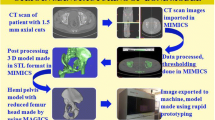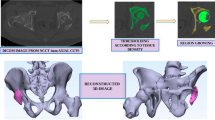Abstract
Background
Acetabular fractures are amongst the most challenging fractures to treat because of complex anatomy. Open reduction and internal fixation remains the standard treatment for displaced acetabular fractures to achieve anatomical reduction as in any other intra-articular fracture. Patient-specific pre-contoured reconstruction plate template made by a pre-operative virtual surgical planning can be useful to respect patient’s morphology, reduce surgical invasiveness and simplify the surgical procedure. Proper evaluation and surgical planning is necessary to achieve these goals. The goal of this study was to evaluate the outcomes of using virtual surgical planning and virtually pre-contoured plate template in comparison with the conventional method of intra-operative contouring of reconstruction plate for acetabular fracture fixation.
Methods
Twenty-five patients were categorized into group A and B by computerized randomization. In group A (12 patients), CT-based virtual surgical planning was done using Mimics and 3-Matic software to form virtually pre-contoured plates, which were 3D printed to act as templates over which 3.5 mm reconstruction plates were manually contoured pre-operatively and used for fixation. In group B (13 patient), conventional method of intra-operative contouring to adapt the plate to the fracture region was followed. Blood loss, surgical time, reduction on X-rays and post-operative computed tomography were compared between two groups.
Results
Duration of surgery and total blood loss were found to be less while reduction was found to satisfactory/anatomical in higher percentage of Group A than Group B patients.
Conclusions
Virtual surgical planning, patient-specific virtually pre-contoured plate template and 3D printing technology improve the outcomes of acetabular fracture surgery by reducing duration and invasiveness of surgery and improving the quality of reduction. However, studies with larger sample size are required to further validate it.







Similar content being viewed by others
Abbreviations
- NCCT:
-
Non-contrast computed tomography
- 3D:
-
Three-dimensional
- DICOM:
-
Digital imaging and communications in medicine
- CAD:
-
Computer-aided design
- RP:
-
Rapid prototyping
- PLA:
-
Poly-lactic acid
- CNC:
-
Computer numerical control
References
Letournel E (1980) Acetabulum fractures: classification and management. Clin Orthop 151:81–106
Matta J, Anderson L, Epstein H, Hendricks P (1986) Fractures of the acetabulum: a retrospective analysis. Clin Orthop 205:230–240
Matta JM, Mehne DJK, Roffi R (1986) Fractures of the acetabulum: early results of a prospective study. Clin Orthop 205:241–250
Rommens PM (2004) The Kocher–Langenbeck approach for the treatment of acetabular fractures. Eur J Trauma 30:265–273
Letournel E, Judet R (1993) Fractures of the acetabulum, 2nd edn. Springer, New York
De Ridder VA, de Lange S, Popta JV (1999) Anatomical variations of the lateral femoral cutaneous nerve and the consequences for surgery. J Orthop Trauma 13:207–211
Tile M, helfet D, Kellam J (2003) Fractures of pelvis and acetabulum. Lippincott Williams and Wilkins, Philadelphia
Baumgaertner MR (1999) Fractures of the posterior wall of the acetabulum. J Am Acad Orthop Surg 7:54–65
Browner BD, Helfet DL (1991) Internal fixation of a fractured acetabulum. Strateg Orthop Surg 10:1–16
Bagaria V, Deshpande S, Rasalkar DD, Kuthe A, Paunipagar BK (2011) Use of rapid prototyping and three-dimensional reconstruction modeling in the management of complex fractures. Eur J Radiol 80(3):814–820 (Elsevier Ireland Ltd; Cited 24 Sept 2013)
Matta JM, Merritt PO (1988) Displaced acetabular fractures. Clin Orthop 230:83–97
Tornetta P 3rd (2001) Displaced acetabular fractures: indications for operative and nonoperative management. J Am Acad Orthop Surg 9(1):18–28
Rommens PM, Hessmann MH (1999) Acetabulum fractures. Unfallchirurg 102:589–590
Zeng C, Xing W, Wu Z, Huang H, Huang W (2016) A combination of three-dimensional printing and computer-assisted virtual surgical procedure for preoperative planning of acetabular fracture reduction. Injury 47:2223–2227
Winder J, Bibb R (2005) Medical rapid prototyping technologies: state of the art and current limitations for application in oral and maxillofacial surgery. J Oral Maxillofac Surg 63:1006–1015
Cimerman M, Kristan A (2007) Preoperative planning in pelvic and acetabular surgery: the value of advanced computerised planning modules. Injury 38:442–449
Citak M, Gardner MJ, Kendoff D, Tarte S, Krettek C, Nolte LP, Hufner T (2008) Virtual 3D planning of acetabular fracture reduction. J Orthop Res 26:547–552
Fornaro J, Keel M, Harders M, Marincek B, Szekely G, Frauenfelder T (2010) An interactive surgical planning tool for acetabular fractures: initial results. J Orthop Surg Res 5:50
Shen F, Chen B, Guo Q, Qi Y, Shen Y (2013) Augmented reality patient-specific reconstruction plate design for pelvic and acetabular fracture surgery. Int J Comput Assist Radiol Surg 8(2):169–179
Brown GA, Firoozbakhsh K, Gehlert RJ (2001) Three-dimensional CT modelling versus traditional radiology techniques in treatment of acetabular fractures. Iowa Orthop J 21:20–24
Brown GA, Milner B, Firoozbakhsh K (2002) Application of computer-generated stereolithography and interpositioning template in acetabular fractures: a report of eight cases. J Orthop Trauma 16:347–352
Duncan JM, Nahas S, Akhtar K, Daurka J (2015) The use of a 3D printer in preoperative planning for a patient requiring acetabular reconstructive surgery. J Orthop Case Rep 5(1):23–25
Maini L, Sharma A, Jha S, Sharma A, Tiwari A (2016) Three-dimensional printing and patient-specific pre-contoured plate: future of acetabulum fracture fixation. Eur J Trauma Emerg Surg. https://doi.org/10.1007/s00068-016-0738-6
Liu ZJ, Jia J, Zhang YG, Tian W, Jin X, Hu YC (2017) Internal fixation of complicated acetabular fractures directed by preoperative surgery with 3D printing models. Orthop Surg 9:257–260. https://doi.org/10.1111/os.12324
Matta J (1996) Fractures of the acetabulum: accuracy of reduction and clinical results in patients managed operatively within three weeks after the injury. J Bone Joint Surg Am 78A:1632–1645
Merema BJ et al (2017) The design, production and clinical application of 3D patient specific implants with drilling guides for acetabular surgery. Injury. https://doi.org/10.1016/j.injury.2017.08.059
Funding
This study has not received any funds/grants from any individual or organization.
Author information
Authors and Affiliations
Corresponding author
Ethics declarations
Conflict of interest
The authors have no conflict of interest.
Informed consent
Informed consent was obtained from every individual participants included in the study.
Ethical approval
Ethical clearance was taken from institute’s ethical committee prior to the study.
Rights and permissions
About this article
Cite this article
Maini, L., Verma, T., Sharma, A. et al. Evaluation of accuracy of virtual surgical planning for patient-specific pre-contoured plate in acetabular fracture fixation. Arch Orthop Trauma Surg 138, 495–504 (2018). https://doi.org/10.1007/s00402-018-2868-2
Received:
Published:
Issue Date:
DOI: https://doi.org/10.1007/s00402-018-2868-2




